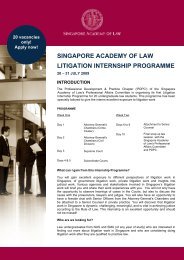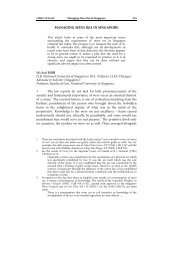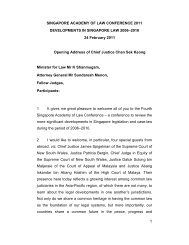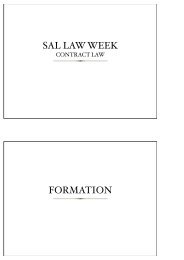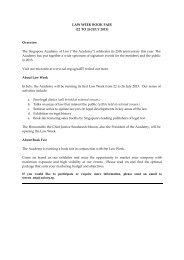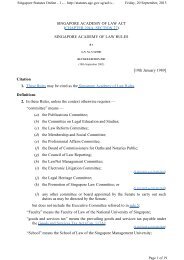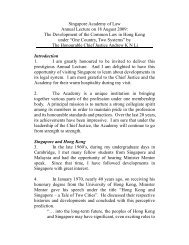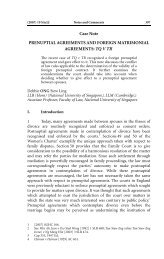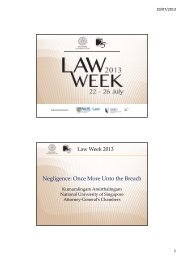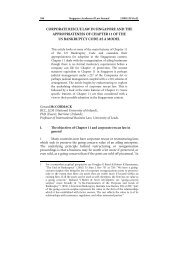View Article - Singapore Academy of Law
View Article - Singapore Academy of Law
View Article - Singapore Academy of Law
Create successful ePaper yourself
Turn your PDF publications into a flip-book with our unique Google optimized e-Paper software.
15 SAcLJ Matrimonial Assets and the 3 rd Party 237<br />
40 In contrast, in the case <strong>of</strong> Yuan Hsiang Ping, supra, the court<br />
was <strong>of</strong> the view that the husband had not recklessly speculated in shares<br />
or accumulated debts. The size <strong>of</strong> the parties’ liabilities had its cause in<br />
the untimely crash <strong>of</strong> the stock market and property market in 1998. The<br />
wife knew that her husband invested heavily in the stock and the<br />
property markets to generate income and enable her to maintain a fairly<br />
high standard <strong>of</strong> living, and all loans taken by the husband in this regard<br />
were taken with the wife’s knowledge. The liabilities were therefore<br />
taken into account in deciding the division <strong>of</strong> the matrimonial assets. 43<br />
41 These two cases seem to indicate that the court will only take<br />
into account those debts incurred for the benefit <strong>of</strong> the family when<br />
making an order under Section 112, and hence when making any <strong>of</strong> the<br />
orders set out in Section 2.4.2.1(a)(i)-(iv) above. In addition, the<br />
definition <strong>of</strong> what constitutes a debt for the benefit <strong>of</strong> the family has also<br />
appeared to have been confined, in the said cases, to those debts which<br />
are undertaken with the intention or purpose <strong>of</strong> acquiring assets or<br />
generating income for the benefit <strong>of</strong> the family.<br />
42 It is submitted, however, that the better view is that:<br />
(i)<br />
The scope <strong>of</strong> what qualifies as a debt incurred for the benefit <strong>of</strong><br />
the family should be widened, to include those debts which were<br />
not incurred with the intention or purpose <strong>of</strong> acquiring assets or<br />
generating income for the benefit <strong>of</strong> the family, but which could<br />
have resulted in this. For example:<br />
If a husband buys a $5,000 watch for himself after the date <strong>of</strong> the<br />
marriage (which has appreciated in value to $8,000 by the time<br />
<strong>of</strong> the ancillary matters hearing), and takes a $5,000 loan to do<br />
so, the watch will be considered a matrimonial asset for division,<br />
notwithstanding that it was not bought with the intention <strong>of</strong><br />
benefiting the family. It seems only fair, in that case, that the<br />
$5,000 debt which was taken to purchase the watch should be<br />
taken into account in assessing the value <strong>of</strong> the watch for the<br />
purposes <strong>of</strong> the division. Otherwise, the party who did not<br />
acquire the asset would have the benefit <strong>of</strong> claiming a share in it,<br />
43<br />
On appeal, the Family Court’s order that the wife’s share <strong>of</strong> the Malaysian property<br />
be transferred to the husband was varied, in that the High Court ordered that the said<br />
property was to be sold and that the wife was to be paid half the sale proceeds. All<br />
the other orders made by the Family Court were not varied. No judgment was written<br />
by the High Court in this matter, however.



